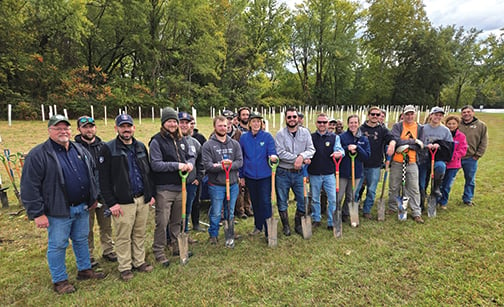Pennsylvania agencies, Chesapeake Alliance partner to plant trees – Outdoor News

Port Trevorton, Pa. — Leaders of the Pennsylvania Department of Conservation and Natural Resources, Fish & Boat Commission and the Alliance for the Chesapeake Bay recently planted a streamside forest buffer at the commission’s Mahantango Access in Snyder County to help prevent flooding and improve water quality in the Susquehanna River.
The Susquehanna River is the largest tributary and ends at the Chesapeake Bay. The University of Maryland’s Center for Environmental Science just rated the Chesapeake Bay’s condition a C+, its best grade in more than 20 years.
The Upper Bay, which is fed by the Susquehanna, scored one of the highest grades among any area of the Chesapeake Bay, a testament to Pennsylvania’s work over the past several years.
MORE COVERAGE FROM PENNSYLVANIA OUTDOOR NEWS:
Growing drought conditions take hold across Pennsylvania
101-year-old Pennsylvania hunter has a ‘tremendous drive’
Pennsylvania Game Commission backs off on private lands proposal
The group planted about 360 trees on 1.3 acres at the Fish & Boat access area along the Susquehanna. The native trees and shrubs include swamp white oak, river birch, American sycamore, silky dogwood and Winterberry. Streams with bare banks are less likely to host aquatic life and fish.
“The commission welcomes the opportunity to join forces with partners to plant streamside buffers at public boat access areas like this one along the Susquehanna River,” said Tim Schaeffer, the agency’s executive director.
“The buffers help filter, absorb, and reduce runoff – at the same time, they help to control stream bank erosion and provide shade, food, and shelter for aquatic organisms.”
These buffer areas are home to many animals that move between land and water, such as reptiles, amphibians, and waterfowl, Schaeffer added.
“Projects like this and others coordinated by our agency’s Chesapeake Bay Watershed Habitat Unit are making a relevant water quality difference locally while improving the health of the Bay – what’s good for the Chesapeake Bay is good for the fish here in Pennsylvania.”
The Alliance for the Chesapeake Bay helps landowners install and care for streamside forest buffers. The organization is approaching its 1,000th acre of buffer planted in Pennsylvania since 2018.
“Planting a riparian forest buffer is a great decision, whether your objectives are wildlife habitat, aquatic habitat, or water quality, according to Ryan Davis, the organization’s senior forests projects manager.
“Between our program and many others, there has never been a better time for Pennsylvanians to sign up for full support to plant and establish forests around their streams.”
The project was supported by a DCNR Community Conservation Partnerships Program grant to the alliance.







